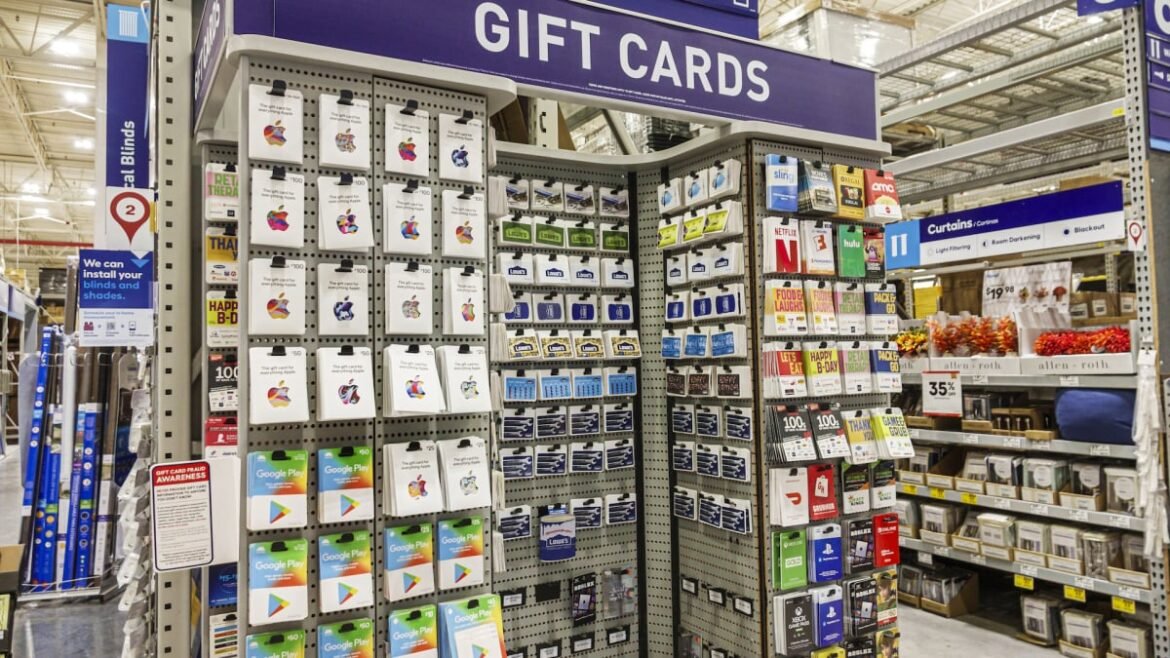The hardest thing about picking a gift card may seem like choosing just one retailer from the many choices.
After all, which gift card will truly delight your tech-loving best friend—Amazon or Apple? What about the co-worker who loves to dine out? Should you go with DoorDash or a national chain like Olive Garden?
While you may be focused on personalizing your pick, there’s something you may have overlooked entirely: the possibility that someone has already collected the data they need from the back of that card to steal the money you’re about to put on it.
The problem with this very real nationwide scam is that it sounds improbable.
But thieves, who are often members of organized criminal networks, go into stores with gift card displays, pocket numerous cards, and tamper with the packaging in order to steal the barcode and PIN that recipients use to activate their card. Sometimes the fraud happens within the store itself, when a cashier swaps out your paid card for a dud during the activation process.
Either way, when the recipient attempts to access their gifted funds, the balance is confusingly zero.
The exact amount of gift card fraud is unclear, but if even one percent of the annual $570 billion Americans load on to gift cards each year is scammed, that could put consumer losses at more than $5 billion, according to an estimate provided to ProPublica.
Aside from purchasing a digital or electronic gift card directly from the retailer or brand, there is no guaranteed way to avoid becoming a victim of gift card draining. But practicing these expert tips can add layers of protection:
1. Inspect the gift card before buying it.
Some scammers have gotten so good at tampering with gift cards that consumers don’t know the difference. While legislation passed in Maryland this year could ultimately improve gift card security nationwide, the products are still vulnerable to tampering.
Mashable Top Stories
That’s why the Federal Trade Commission recommends making sure that a card still has its protective sticker, and that it doesn’t appear to have been manipulated. The PIN number on the back also should not be visible. If you suspect a card has been tampered with, give it to a store employee and choose a different one.
2. Keep a copy of the gift card and the store receipt.
The FTC recommends taking a picture of both the gift card and your purchase receipt. The card information, plus the transaction data on the receipt, can help you report fraud to both the gift card company and the store.
The FTC maintains contact information for major gift card companies. If you don’t see contact information for your card on the FTC’s list, try using the details provided on the card itself. Report it to the FTC if the card issuer cannot be reached or refuses to speak with you.
3. Buy gift cards from trustworthy merchants.
You might be tempted to buy a gift card from an online auction site or other third party, but their offerings may be fake or stolen. For extra peace of mind, Jory MacKay, head of editorial content for the online safety product Aura, recommends buying gift cards directly from the brand’s website.
4. Purchase a gift card using a credit card with fraud protection.
If you have a credit card with fraud-protection benefits, MacKay suggests using it for a gift card purchase. That’s because credit cards typically offer better security for unauthorized charges and may come with $0 fraud liability if you’ve been deceived by a scam. Be sure to keep the receipt as it will have details you may need to share with the credit card company.
5. Consider buying multiple gift cards instead of one card for a large amount.
Sure it can be satisfying to hand a loved one a gift card for an eye-popping value, but purchasing a number of smaller cards instead may be the wiser move, says MacKay. This way, your loss may be minimal if you unknowingly bought a drained card.
6. Register the card online, if possible.
You can register some gift cards online, which typically offers more protection and options to freeze the card or track the balance, says MacKay. It’s also easier to report a drained card when it’s been registered.
7. Quickly use the card’s balance.
When you hand the card to the recipient, you might gently encourage them to spend the balance sooner than later, and register it if that’s not already been done.
MacKay says unused cards are more vulnerable to potential theft and hacking.
If the card you gifted has a balance of zero, MacKay recommends first checking to make sure you have the receipt.
Then, contact the retailer or card issuer. They can help you determine whether the card was drained or tampered with prior to purchase. MacKay says that trusted stores and brands are likely to replace or refund the card, especially if you’re quick to report the problem.
“The key is to act fast—getting on top of the issue early can help make sure your recipient gets the full value of their gift,” MacKay says.

